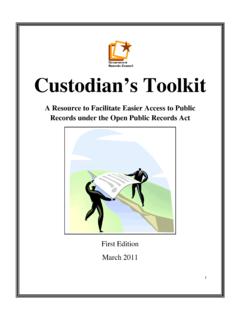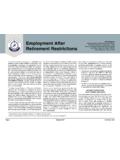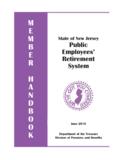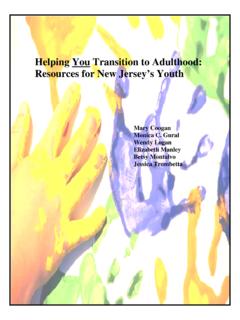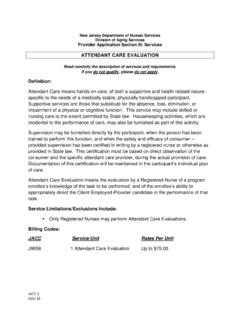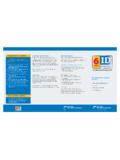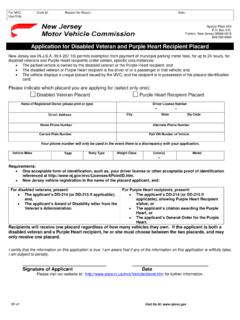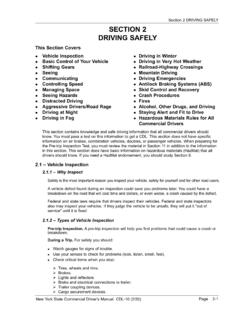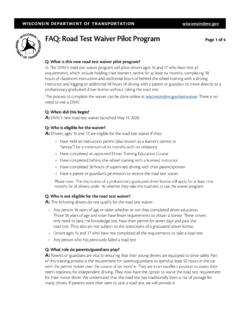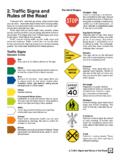Transcription of New Jersey Department of Education New Jersey Department ...
1 Updated September 1, 2021 The Road FHealth and Safety Guidance for the 2021-2022 School YearorwardNew Jersey Department of EducationNew Jersey Department of HealthGovernor Philip D. MurphyLieutenant Governor Sheila Y. OliverAngelica Allen-McMillan, Commissioner, New Jersey Department of EducationJudith M. Persichilli, , , , New Jersey Department of HealthIntroduction Local Education Agencies (LEA) must plan to provide full-day, full-time, in-person instruction and operations for the 2021-2022 school year. The New Jersey Department of Education (NJDOE) and New Jersey Department of Health (NJDOH) worked collaboratively to develop the following guidance to operationalize that goal.
2 This guidance includes a range of strategies that LEAs should consider implementing to reduce risks to students and staff from COVID-19 while still allowing for fulltime in-person learning. The absence of one or more of the strategies outlined in this document does not preclude the reopening of a school facility for full-day in-person operation with all enrolled students and staff present. While the State is committed to a resumption of normalcy for next school year, we will continue to monitor the data and our decisions will be guided by science to ensure that we maintain safe and healthy school communities. This document also contains expectations for the fall learning document contains recommendations for public schools rather than mandatory standards, with the exception of the mandatory masking requirement for all individuals in public, private, and parochial preschool programs and elementary and secondary schools, including charter and renaissance schools, per Executive Order 251 and vaccination or testing requirements pursuant to Executive Order schools may also utilize this document as they plan for full school reopening in should anticipate potential updates to this guidance prior to the start of the new school year.
3 As additional federal recommendations from the Centers for Disease Control and Prevention (CDC) become available. To sign up to receive health alert messages, contact your local health Department or request a new account at 31 General Health and Safety GuidelinesWhere possible, the following recommendations should be used to develop a layered approach to help prevent the spread of COVID-19. Schools should implement as many layers as should consider, in close consultation with their local and/or county public health officials, as many factors as feasible as they prepare for the 2021-2022 school year, including the level of COVID-19 transmission in the community at large and in their school community, as well as vaccination coverage rates in both the community at large and their school community.
4 Vaccination Vaccination is currently the leading public health prevention strategy to end the COVID-19 pandemic. Promoting vaccination can help schools safely return to in-person learning as well as extracurricular activities and sports. (updated 8/2021)Although COVID-19 vaccines are safe, effective, and accessible, not all school-aged children are currently eligible to be vaccinated. Most K-12 schools will have a mixed population of fully vaccinated, partially vaccinated, and unvaccinated individuals at any given time, thereby requiring the layering of preventive measures to protect all individuals. LEAs are encouraged to have a system in place to determine the vaccination status of students, however, if an LEA is unable to determine the vaccination status of individual students, those students should be considered not fully vaccinated.
5 LEAs should be collecting vaccination information from staff in accordance with the terms of Executive Order No. 253.(updated 9/1/2021)Public confidence in immunization is critical to sustaining and increasing vaccination coverage rates and preventing outbreaks of vaccine-preventable diseases. LEAs should actively promote vaccination for all eligible students and staff. As vaccine eligibility expands, LEAs should consider school-wide vaccine coverage among students and staff as an additional metric to inform the need for preventive measures such as physical distancing and masking (NJDOH COVID-19 Recommendations for K-12 Schools).Many school-aged children missed recommended vaccines over the last year due to disruptions associated with COVID-19.
6 LEAs should review and consider the CDC resources that may be helpful in addressing low coverage in children and preparing for a safe return to school. LEAs are encouraged to send reminders to families about school immunization requirements and follow up with families of children who are not in compliance with requirements and encourage compliance.(updated 8/2021)Pursuant to Executive Order No. 253, all LEAs, nonpublic schools, and parochial schools must maintain a policy that requires all covered workers to either provide adequate proof that they have been fully vaccinated or submit to COVID-19 testing at minimum one to two times weekly. Covered workers includes individuals employed by the LEA or school, both full and part-time, including, but not limited to, administrators, teachers, educational support professionals, individuals providing food, custodial, and administrative support services, substitute teachers, whether employed directly by the LEA or school or otherwise contracted, contractors, providers, and any other individuals performing work in the LEA or school whose job duties require them to make regular visits to such covered settings, including volunteers.
7 Covered workers does not include individuals who visit the covered setting only to provide one-time or limited duration repairs, services, or construction. Additional information regarding collection of staff vaccination information, timing for compliance, and the manner of testing is outlined in Executive Order No. 253.(updated 9/1/2021) Communication School officials and local health departments should maintain close communication with each other to provide information and share resources on COVID-19 transmission, prevention, and control measures and to establish procedures for Local Health Department (LHD) notification and response to COVID-19 illness in school settings.
8 LEAs should work closely with LHDs as they make decisions regarding which mitigation strategies to implement and when based on data.(updated 8/2021)Understanding that COVID-19 may impact certain areas of the state differently, NJDOH provides information on COVID-19 transmission at the regional level, characterizing community transmission as low (green), moderate (yellow), high (orange), and very high (red). This information is posted online every week on the NJDOH CDS COVID-19 website and sent out via New Jersey Local Information Network and Communications System (NJLINCS) to public health and healthcare partners. Municipal level vaccination coverage data is posted online at MasksWearing masks is an important prevention strategy to help slow the spread of COVID-19, especially when combined with everyday preventive actions and social distancing in public settings.
9 On August 5, 2021, the CDC issued new indoor masking recommendations for individuals in K-12 school settings. That guidance is available here: Indoors: In alignment with recommendations from the CDC and the American Academy of Pediatrics, on August 6, 2021, Governor Murphy signed Executive Order 251 which requires that all staff, students, and visitors wear a mask, regardless of vaccination status, in the indoor premises of school buildings. This requirement applies to all public, private, and parochial preschool programs and elementary and secondary schools, including charter and renaissance schools. As outlined in the Executive Order, there are limited exceptions to this requirement (see full list below).
10 Outdoors: In general, people do not need to wear masks when outdoors. The CDC recommends that people who are not fully vaccinated wear a mask in crowded outdoor settings or during activities that involve sustained close contact with other people. Fully vaccinated people might choose to wear a mask in crowded outdoor settings if they or someone in their household is immunocompromised.(updated 8/2021)The following principles apply to the use of masks in schools: }Information should be provided to staff and students on proper use, removal, and washing of masks.}The most effective fabrics for cloth masks are tightly woven such as cotton and cotton blends,breathable, and in two or three fabric layers.
